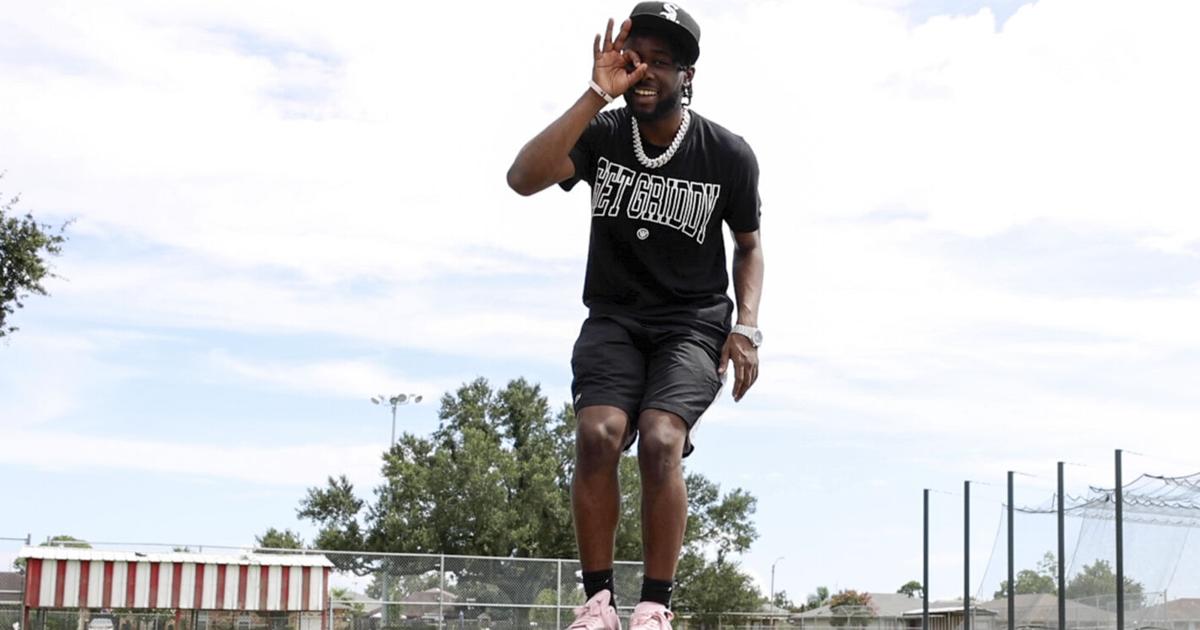
Standing on a concrete slab in the middle of an empty park last month, Allen Davis waved off the need for background music. He had performed his dance so many times over the years, the moves felt as familiar as walking.
“I got my own rhythm,” Davis said.
Davis faced a photographer and started teaching The Griddy, a dance craze that has stretched far from his control. Wasps buzzed in the muggy air. Puddles from a morning downpour dotted the field in Kenilworth Park where he played his first baseball game. Davis tapped his heels back and forth as he rapped “Right Foot Creep” by YoungBoy Never Broke Again, the song often associated with the dance.
“Right foot creep oh walking with them B’s,” Davis mumbled, mixing instructions with the lyrics while he danced.
Davis formed a circle with his thumb and his index finger for the B’s — a signature move that means big billionaires — and raised them to his eyes like goggles. He wore black athletic shorts and a black “GET GRIDDY” t-shirt from his personal merchandise line. A pair of $500 pink and gray Alexander McQueen sneakers bounced along the pavement.
Fueled by Louisiana natives in the NFL, especially former LSU wide receivers Justin Jefferson and Ja’Marr Chase, the dance has morphed into a national sensation over the last three years and reached athletes in other countries. It often gets used as a touchdown celebration. It appeared at the Tokyo Olympics. It trends on social media and shows up in video games, including the next edition of Madden.
Similar fads have come and gone over the years. There was the Dougie, the Nae Nae and the Floss. All of them surged and then faded into the cultural background, often replaced by the next popular dance.
But The Griddy has continued to grow by embedding itself in professional sports leagues. Soccer star Christian Pulisic tapped his heels after a goal. New York Yankees outfielder Aaron Judge did The Griddy after hitting a game-winning home run. NBA All-Star Ja Morant adopted the dance early on, and the Golden State Warriors mocked him by doing it when they beat the Memphis Grizzlies in the playoffs. It might have staying power.
"We ain't ever know it was going to get this big," Davis said.
There’s something infectious about the dance. Three to four basic moves makes The Griddy easy to learn, and the natural bounce cheers people up, almost making it an extension of the city it came from. Plus, the moves can be done to almost any tune because they didn’t come from a specific song like some other social media trends.
"It's the way he moves with it," said Davis' father, Allen Davis III. "It's the bounce. And he can do different things within the dance. He can bounce and bring his arm around. That's so New Orleans to me, man. It's the swag. It's the swag. It's the movement that comes with the footwork of the dance."
Davis does The Griddy everywhere. He’ll mindlessly tap his heels at home. People approach him in public. Once, he went to Popeyes and the employees danced behind the counter.
Trying to capitalize on his creation, Davis encourages the interactions. The more popular the dance becomes, the better chance he has of profiting from it. The steps have become his livelihood. He hopes to turn them into a sustainable long term career.
The struggle is getting a national audience to recognize that he started the dance. He can’t copyright the moves, and The Griddy has become so common that casual fans may not know who came up with them. Davis wants to change that.
“I wish they knew it was me,” Davis said. “But I'm still getting out there.”

Allen Davis, the creator of the popular dance the Griddy, sits in his family's home as he talks about how the dance originated in New Orleans, Friday, July 29, 2022. (Photo by Sophia Germer, NOLA.com, The Times-Picayune | The New Orleans Advocate)
Sophia Germer•••
The craze started organically, as many often do. Davis always liked to dance, sometimes challenging other people at parties, and as a freshman in 2017, he bounced around on his heels while his teammates blasted hype music before Landry-Walker High School football practices.
One day, a friend filmed Davis as he stepped and threw his B’s in the locker room. Davis posted the video on Snapchat. When he woke up the next morning, more than 100 people had recorded the clip. His classmates imitated the moves in the hallway at school.
“I wasn't trying to make it famous,” Davis said. “I wasn't trying to make the whole world do it. Other people were trying to do it, and I'm like, ‘Dang, I might as well call this my dance then.’ ”
Davis needed a name. He tried to think of something like the Nae Nae, another dance he loved.
As he searched, Davis came back to his own nickname. He had already dubbed himself “Lil’ Griddy” after a cousin he admired named “Big Gritty,” leaving the name on pieces of paper at his mother's house. He decided to adapt something that felt unique to him.
“I named it after me so everybody could know I created it,” Davis said.

Allen Davis, the creator of the popular dance the Griddy, "throws up his Bs" as he does the dance at Kenilworth Playground in New Orleans, Monday, Aug. 1, 2022. (Photo by Sophia Germer, NOLA.com, The Times-Picayune | The New Orleans Advocate)
Sophia GermerThe dance spread through social media to other New Orleans high schools, and about a year later, Davis started working out with Chase at the GLS Training Facility in Marrero.
Chase, a senior wide receiver for Archbishop Rummel at the time, trained there from eighth grade until he reached the NFL. Davis used the gym to improve as an undersized defensive back. They danced together between reps.
“The Griddy was done every day, all the time in the gym,” GLS owner Gary Scheffler said. “That's all them dudes would do.”
Chase, who could not be reached for this story, brought the dance with him to LSU, where he introduced it to Jefferson. During their record-setting 2019 season, Chase and Jefferson constantly danced through the end zone after a combined 38 touchdowns. As they bounced and threw the B’s over their eyes, The Griddy became associated with the most prolific offense in college football history.
With people drawn to that LSU team and its swagger, the dance grabbed national attention. That same year, New Orleans-based rapper Kenneth Brother released a song called “Griddy.” Word spread further. Even if Davis was on the sideline, opposing high school players did The Griddy whenever they scored against Landry-Walker.
At the end of the season, LSU played Clemson for the national championship in the Superdome. Davis worked concessions selling Dippin’ Dots. Chase scored twice. After his first touchdown, a 52-yarder down the sideline, he did The Griddy. Davis tried to catch a glimpse from the concourse.
fortnite macarena
If you're a Tiger fan you won't want to miss this newsletter. Sign up today.
“I'm looking at it on the screen,” Davis said, shaking his head. “Bro really just scored and hit The Griddy.”

Allen Davis, the creator of the popular dance the Griddy, poses at Kenilworth Playground in New Orleans, Friday, July 29, 2022. (Photo by Sophia Germer, NOLA.com, The Times-Picayune | The New Orleans Advocate)
Sophia Germer•••
The dance took off while Davis finished high school. A few months after he graduated, former LSU running back Clyde Edwards-Helaire did The Griddy during his NFL debut. The rest of the league began to notice, and Jefferson made the moves famous by dancing whenever he scored. Morant helped push it into other professional sports.
Few knew about Davis, who briefly attended Southern University that fall. He tried to capitalize by posting tutorial videos and vlogs on YouTube. He created merchandise. He responded to tweets. He filmed a music video with Brother, and he started writing his own songs to accompany the dance, trying to make sure people associated The Griddy with him.
In the spring of 2021, Epic Games sent Davis an email. The company wanted Jefferson — the first NFL player featured in Fortnite — to use The Griddy as a celebration emote in the online video game.
The initial offer was $10,000. Davis’ agent negotiated. He said he received $80,000 in the end, marking his first significant payday.
“I woke up, and my bank account had a whole lot of money in it,” Davis said. “I don't even play Fortnite.”
After that, Davis dedicated himself to monetizing the dance. He established himself on TikTok and Instagram, where he now has a combined 169.1 thousand followers. He filmed more videos. He posted clips of athletes doing his moves. He danced at schools around the country. Whenever someone did The Griddy, Davis recognized them online, hoping people would do the same for him.
At the same time, The Griddy became one of the most popular celebrations in the NFL last fall. ESPN sent a video crew to New Orleans to film Davis and Brother dancing in the French Quarter for a segment, and he got more attention as leagues and athletes tagged him in their posts. The NFL sent him to multiple games, increasing his exposure.
In January, Davis and Scheffler drove to Cincinnati to watch the Bengals host the Chiefs near the end of the regular season in a suite with Chase’s parents. They had to stop multiple times for people to take pictures and dance with Davis as they entered the stadium.
Davis seems suited for the attention. He looks comfortable in public. He smiles and laughs as he moves, and his enthusiasm makes people want to dance with him more. On the way home from the game, Davis taught the employees at a McDonald’s how to do The Griddy.
“Everywhere he goes, they're going to do The Griddy,” Scheffler said. “You never know who's next is the funny part. When people find out it's him, they want to be a part of it."

Allen Davis, the creator of the popular dance the Griddy, sits in his family's home as he talks about how the dance originated in New Orleans, Friday, July 29, 2022. (Photo by Sophia Germer, NOLA.com, The Times-Picayune | The New Orleans Advocate)
Sophia Germer•••
The more he promotes himself, the more Davis has turned into a social media personality and influencer.
He danced with basketball players at Kentucky and the cheerleading team at Xavier. The Pelicans gave him courtside tickets. He attended a football camp hosted by Minnesota Vikings tight end Irv Smith Jr., a New Orleans native and friend.
This spring, LSU’s staff asked Davis to come to an official visit weekend. He danced with recruits and coach Brian Kelly.
“I just started teaching him the B’s, the one-two tap,” Davis said. “He just started hitting it. I didn't think he was going to do it right then and there.”
Davis wants to continue growing his brand. He hopes to expand the team around him and collaborate with shoe companies. He envisions merchandise and songs. He plans to tour major colleges this fall, including another stop at LSU. He thinks of himself as content creator.
“He knows it's big, but he's a humble kid, too,” Scheffler said. “He's not cocky. He's not arrogant. But I guess when you got the best dance — it might be comparable to something as big as the Macarena before it's all over with.”
The dance’s growing popularity has made Allen recognizable in parts of New Orleans. People run up to him at the mall. He gets swarmed in certain areas, making him hesitant to go out because he doesn’t always want to attract attention.
“I feel like I'm Drew Brees' mom,” said Davis’ mother, Tewaina Poole.
Poole and other people in Davis’ orbit worry about all this at times. He signed a bad contract with his first agent, and others may try to take advantage of him in the future. Money can also lead to jealousy and violence.
Davis understands those risks, but he feels determined to support himself with The Griddy. He said he gets paid through YouTube, Instagram and TikTok. He received a significant sum from Madden, which featured him in an advertisement. This summer, Fortnite flew him to California and paid him $3,000 to dance on stage during an event.
“If I'm getting that type of money dancing, I'm going to keep going,” Davis said. “People work 9 to 5 and be making like $500 a week. I'm making three bands in one day just hitting The Griddy. So I'm not worried about getting a job.”
Sometimes, Davis looks around bewildered, stunned that so many people love what he created. He believes in what he can accomplish through his dance. Everyone may not know him yet, but wider recognition is coming.
After he finished the tutorial, Davis walked into a convenience store for a yellow Gatorade and nacho cheese Doritos.
“What’s happening, Griddy?” someone asked him inside.
Davis came back out with his snacks in a plastic bag.
“I didn't even know who that was,” Davis said. “He said he went to school with me. Anywhere I go, people know who I am.”